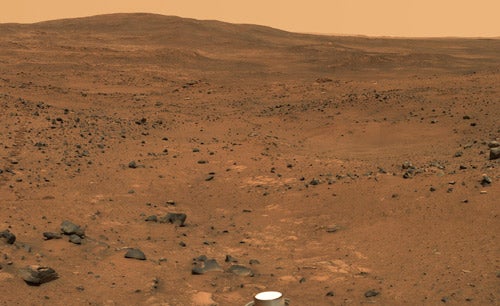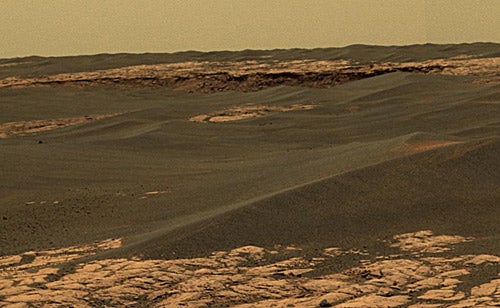Spirit and Opportunity, the twin Mars Exploration Rovers (MERs), are still operating after 7 times their design life. Mission scientists gave updates on both rovers’ conditions and discoveries at the fall meeting of the American Geophysical Union this week in San Francisco.
Having spent 14 months climbing to the top of 270-foot-tall (82 meters) Husband Hill, Spirit is now making its way down the other side of the slope. When it gets to the bottom, the rover will crawl a quarter mile (0.4 kilometer) across the plain to examine Home Plate, a 230-foot-wide (70m) flat, hard patch that seems to be the biggest piece of unified bedrock in the area. Spirit will then hastily roll up a north-facing slope. Martian winter is coming, and Spirit must once again get onto a north-facing slope and tilt its solar array toward the dimming winter Sun in order to give it enough power to survive.
The Columbia Hills are an isolated patch of Gusev Crater’s original surface. According to chief scientist Steve Squyres, Spirit’s main discovery about the rocks there is their “extraordinary diversity.” Ten different rock types intermix within the single mile the rover has driven in the region. Squyres says there is more geological variety there than in most places on Earth.
Most of the rocks have been exposed to only small amounts of short-lived groundwater or to steam during volcanic eruptions or meteor impacts. In a few cases, they have been exposed to much water, but their original basalt is usually much less modified than the rocks Opportunity has been exploring at Meridiani Planum.
Opportunity is wending its way south across the low-rippled dunes of basalt sand that cover the Meridiani plain. The rover has found nothing there to change scientists’ confidence that the layered rock encountered in Endurance Crater was created when basalt was exposed, roughly 3 billion years ago, to a strong solution of sulfuric acid in water.
The solution broke down the basalt into sulfate salts mixed with loose silicate particles, along with little, hard hematite spherules. These spherules, or “blueberries,” grew by chemical reactions in the sediment from basaltic iron dissolved in the acid brew.
The MER team thinks the acid usually took the form of groundwater that periodically drenched the subsurface. The rock was then slowly ground into soft, dry sand blown into dunes before the next wetting episode re-cemented them. Only occasionally does the water level seem to have risen above the soil surface, leaving behind a record of much smaller ripples of the type produced by water currents rather than air.
Opportunity has found varying concentrations of sulfate salts and varying numbers and sizes of blueberries on its southward drive. This indicates both the amount of fluid and the strength of its acidity changed during the hundreds of thousands of years of repeated wet episodes.
The rover is currently on the edge of “Erebus,” a big but eroded crater in the sand-covered plain. In addition to a jammed steering motor on the right front wheel, the instrument arm’s shoulder-joint motor, which controls the horizontal axis, has failed. MER team members express “cautious optimism” about future measures that might restore its ability to touch and analyze the surface, albeit awkwardly. If this proves impossible, the rover can still take images and make analyses with its infrared spectrometer.
If the rover regains use of the arm, it will examine an interesting set of strata on the crater’s opposite rim. Opportunity will then quickly maneuver 1.3 miles (2 km) south to reach Victoria Crater before winter cuts down its power supply. A magnificent half-mile-wide (0.8 km) crater visible in orbital images, Victoria’s several hundred feet of visible layering should provide still more information on the history of Meridiani’s formation.











